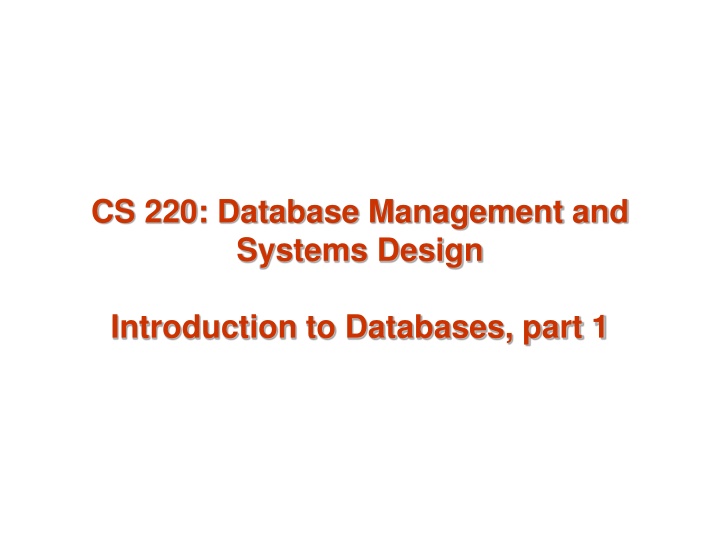
Introduction to Database Management and Systems Design - CS 220 Course Overview
Explore the foundational concepts of database management and systems design in CS 220. Learn about the course structure, grading criteria, textbook usage, and the significance of databases in applications like Facebook. Gain insights into data storage and memory management. Dive into the world of databases with this comprehensive introduction.
Download Presentation

Please find below an Image/Link to download the presentation.
The content on the website is provided AS IS for your information and personal use only. It may not be sold, licensed, or shared on other websites without obtaining consent from the author. If you encounter any issues during the download, it is possible that the publisher has removed the file from their server.
You are allowed to download the files provided on this website for personal or commercial use, subject to the condition that they are used lawfully. All files are the property of their respective owners.
The content on the website is provided AS IS for your information and personal use only. It may not be sold, licensed, or shared on other websites without obtaining consent from the author.
E N D
Presentation Transcript
CS 220: Database Management and Systems Design Introduction to Databases, part 1
About the course Administrivia Instructor: Peter Story Happy to answer emails, meet before/after class, etc. Office hours: 1pm-3pm on Fridays, location TBD Website: - Check frequently! - Syllabus, schedule, assignments, readings, - Lecture slides Course design was adapted from material by Zhenguang Gao and George Kollios (and John and Tricia Magee)
Textbook Fundamentals of Database Systems (7th Edition) By Ramez Elmasri and Shamkant Navathe
Grading Attendance, participation, professionalism: 10% Homework / Programming assignments: 30% Quizzes (~6): 30% Final Project and Presentation: 30% 2 minute quizzes at start of class will count towards participation.
Who are you? Introduce yourself to me and the class: Why are you taking this course? Full time student? Work? What programming/web experience do you have? Anything else?
Facebook: Usage Statistics http://www.facebook.com/about#!/press/info.php?statistics March 2010 7
What is Facebook, anyway? Core Applications Profile, friends, social network, inbox, photos, groups, events, Platform Enables developers to write their own Facebook applications. 8
How does Facebook generate your page? Facebook is a data-driven application. What kind of data? Profiles, Status, Friends, Groups, Friends, Events, Photos, etc. All of this data is stored in a database. What s a database? 10
Storing Data: Memory Memory is used to store programs and other data that are currently in use. LOAD, STOR operations Advantage of memory: short access times Read/write times in nanoseconds (10-9 sec) Disadvantages of memory: relatively expensive ($/byte) volatile 11
Storing Data: Secondary Storage Secondary storage is used to store data for later use (examples: disks, CD, DVD). Data is written from memory to disk. When needed, data is read back into memory. 12
Secondary Storage Advantages of secondary storage: relatively inexpensive ($/byte) not volatile Disadvantage of secondary storage: long access times Read times in milliseconds (10-3 sec). in 10 ms, a modern CPU can perform millions of operations! Thus, it's important to minimize the number of times that the disk is accessed. 13
Example: Facebook Profile What info is on a Facebook profile page? First Name Last Name Email Password Birthday About me Activities Favorite Books Favorite Movies Favorite Music Favorite Quotes Favorite TV shows No matter which page you view, it has these same elements These data are stored in a database table. 14
Whats a Table? Each table (sub-collection) is a collection of records, and each record contains fields. Example: a profiles table The primary key is a field which uniquely identifies one record within a table. Consider this URL: http://www.facebook.com/profile.php?id=125490994 15
Primary Key The Primary Key: uniquely identifies a record within a table is an ideal search key is a way to create relationships between different tables Consider this URL again... http://www.facebook.com/profile.php?id=125490994 16
Example: Status Updates Not all data fits neatly into the profile table. Consider status updates A separate Status table tracks all status updates for all users. What fields does it need? timestamp, userid, status 17
Example: Status Table Each status message is related to exactly one profile by the foreign key (the field called id ). These ids are called a foreign key, because they are primary keys in another table. 18
Example: Friends The Facebook friend relationship is created by an entry in a friend table. Each record has two user ids: These ids are called a foreign keys, because they are primary keys in another table. 19
Databases A database is: a collection of data stored in a way to enable quick access organized into related sub-collections called tables. Example: a mini facebook database: A profiles table has records of each user A status table has records of status messages A friends table has records friend relationships Each table (sub-collection) is organized by records, and each record contains fields. 20
Database Management Systems A database is a collection of data (not software). A database management system (DBMS) is the software which manages a database. Functions of a DBMS: Efficient storage and access Providing a logical view of data (tables, records) Query processing Transaction management 21
Function: Efficient Storage and Access Indexing enables efficiently locating a record based on some unique attribute, called a key. Example: looking up stocks by their symbol. Example: update the record for symbol= FB A hash index can make these operations O(n) A b-tree index can make these operations O(log n) 22
Function: Logical View Abstraction Representing the data as tables and rows, so programmers (usually) don t need to think about how the data is physically stored on disk (e.g., in which files?) 23
Function: Query Processing A query language is used to access and modify the data. SQL (Structured Query Language) is the standard for relational databases. Many different database vendors support SQL: Oracle, Sybase, IBM DB2, MS SQL Server, MS Access PostgreSQL, MySQL, SQLite (free/open-source) 24
Function: Transaction Management ACID properties: Atomicity All of a transaction must be completed, or none of it Consistency (Correctness) Don t allow the database to enter a corrupted state Isolation Concurrently executed transactions must have the same effects as sequentially executed transactions (since databases usually have multiple users) Durability After a transaction completes, it should persist even if the power fails, etc.
What is a Database System? Database: Models a real world enterprise: Entities (e.g., teams, games / students, courses) Relationships (e.g., The Celtics are playing in the Final!) Even active components (e.g. business logic ) DBMS: A software package/system that can be used to store, manage and retrieve data form databases Database System: DBMS+data (+ applications) A very large collection of related data
Why Study Databases? Shift from computation to information Always true for corporate computing More and more true in the scientific world and of course, Web New trend: social media generate ever increasing amount of data DBMS encompasses much of CS in a practical discipline OS, languages, theory, AI, logic
Advanced Topics Data Analytics is an important domain Given large amount of data in the database, how can you use them to help you take business decisions? Cluster based data analytics: Map-Reduce, shared nothing DBs Main memory databases (NVRAM)
Outline Application-oriented How to develop database applications: User + DBA For learning, we will do things the hard way (i.e., using lightweight frameworks). In the real world, I recommend a featureful framework like Django, but doing things the hard way will show the value of more featureful frameworks. System-oriented Learn the internals of a relational DBMS





